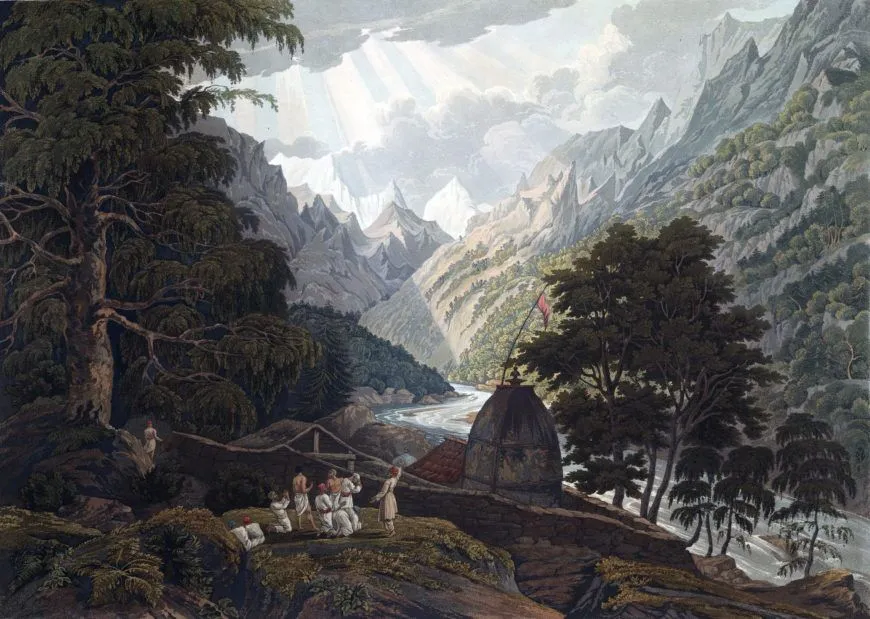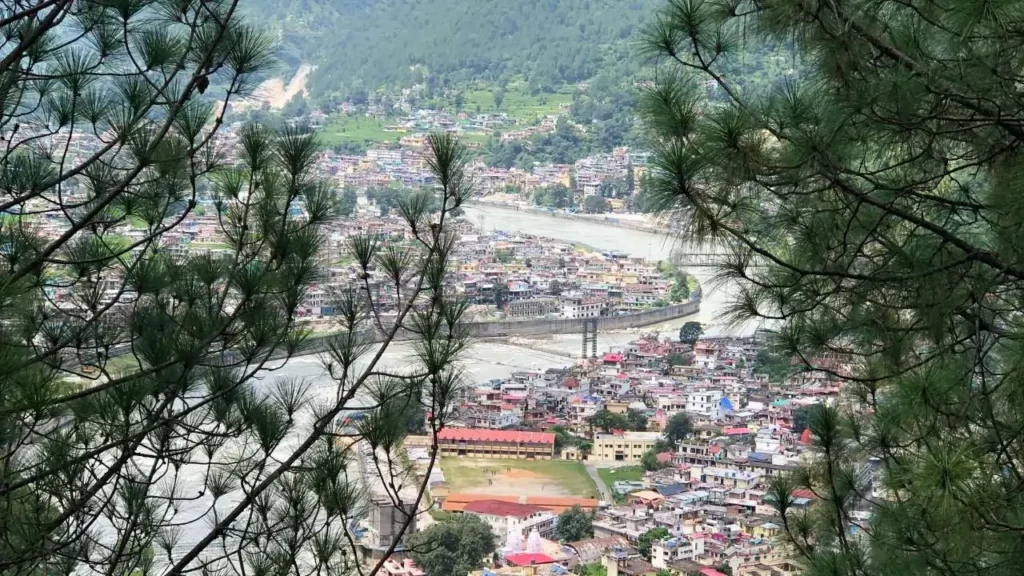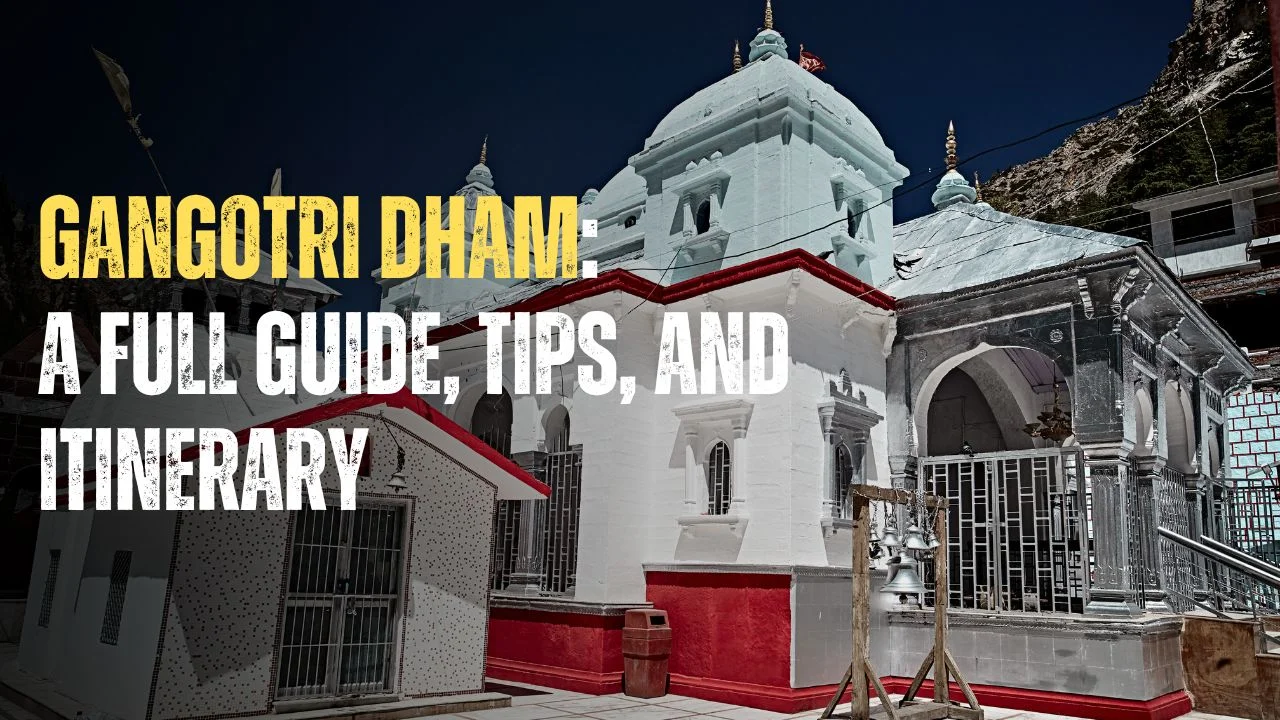The sacred village of Gangotri in Uttarkashi district is situated on the banks of the Bhagirathi River and surrounded by towering Garhwal Himalayas at an elevation of 3140m. It is home to Gangotri Temple, the highest Hindu temple dedicated to Goddess Ganga. Being one of the four important Hindu pilgrimage sites- Char Dham, Gangotri draws thousands of devotees every year. This small village attracts nature lovers, spirituality seekers, and adventurers with its beautiful views and divinity.
This detailed guide will cover the itinerary, the history of Gangotri temple, how to reach here, and the best time to visit, to help you plan a memorable trip.
Table of Contents
Gangotri Dham: Mythological and Historical Significance
The Gangotri Temple is of great religious importance for the Hindus for their culture, mythology and traditional customs. Here, we will discuss the inception of the temple, its old legends, its architecture, and local attractions:

Origin of Ganga River
As per an old legend, King Bhagirath prayed and stood on one leg for 5,500 years to persuade goddess Ganga to descend and wash off the sins of his ancestors, freeing them from the Sage Kapil’s curse. Impressed by his dedication, Lord Vishnu allowed the Ganga River to land from heaven to Earth. But, due to the turbulent nature of the river and the damage it might cause, Lord Shiva had to intervene. He directed Ganga to strike his head before descending, cautiously absorbing the tremendous force and protecting Earth from destruction. This legend is supported by the submerged Shivling perched inside the Ganga Temple.
It is believed that the river washed the ashes of Bhagirath’s 60,000 ancestors and made the land fertile and pious. Bhagirath guided the flow of the Ganga across India, where she split herself into many tributaries. This is why, as per Hindu legends, the river is called Bhagirathi at the origin. The spot where the king meditated is called “Bhagirath Shila,” placed near the main temple.

It is said that the Pandavas performed ‘Dev Yagna’ at Gangotri Dham after defeating the Kauravas in the battle of Mahabharat to atone the deaths of their relatives.
History
The history of the Gangotri Temple can be traced back to medieval India, when the Vedic philosopher, Guru Adi Shankaracharya arrived in Rishikesh, Uttarakhand, on his mission to spread Hinduism. As per Garhwal ka Itihas by Harikrishan Raturi, Adi Shankaracharya laid the initial foundation of the Ganga Temple in Gangotri Dham.1 The small temple made of Deodar wood, became a religious hub for the Ganga worshippers.

2However, the devastating 1803 Garhwal earthquake destroyed the villages and temples of the Garhwal region.3 In 1804, the Nepalese army of Gorkhas took over the regions of Garhwal, Kumaon, and Sirmour. The Gorkha General Amar Singh Thapa showed his interest in the Temple. He took it upon himself to renovate the earthquake-hit village of the Gangotri. Amar Singh Thapa arranged funds for the construction of Gangotri Dham temple and the roads leading to it. The new temple was made using white Granite, with Shikharas made in the Nepalese Katyuri style of architecture. In addition to this, Thapa ordered the construction of three to four huts for the pilgrims to stay.4 These major reforms by the Gorkha leader have significantly contributed to the popularity of the sacred site across the country.

Later in the 1890s, The then-Maharaja of Jaipur, Sawai Madho Singh II, renovated the Gangotri Temple in Nagara style of architecture, giving it a more finished look.5
Fun Fact: Maharaja Sawai Madho Singh II holds the Guinness Book of World Records for the sterling silver urn ‘Gangajali’ (weighing 345kg), which he used to transport Ganga Jal, the holy Ganga water to England.
Architecture
The present Gangotri Dham Temple is made in Nagara style and has five Shikharas approximately 20 ft in height. The Garbha Griha of the temple consists of the idol of Goddess Ganga on a raised platform completed by a set of other idols of Goddess Annapurna, Yamuna, Lakshmi, Saraswathi, Sage Bhagirath, and Sage Adi Shankara. The Sabhagriha or mandapa of the temple is placed in the front, for devotees to pray and assemble during the festivals.

The temple compound houses a statue of Adi Shankaracharya to commemorate his significant contributions to promoting the Char Dham Yatra. The Gangotri temple compound has four more temples dedicated to Lord Hanuman, Shiva, Ganesh, and Bhagirath.
Significance for the Hindu devotees
The Hindu devotees consider the holy River of Ganga as a mother, goddess, and protector. Gangotri Dham, being home to Ganga’s source, holds supreme significance as a pilgrimage site. The origin of the Ganga River, the Gaumukh Glacier, is 19km from the Gangotri valley, where it is called Bhagirathi.

As per old legends, when the Ganga River descended on Earth, it carried ten rare Vedic Yogas. These ten astrology calculations, redeem the devotees of their sins when they soak in the holy river on the occasion of Ganga Dussehra.
The pilgrims visit Gangotri, every year, for a ritualistic dip in holy water and offer their prayers to Goddess Ganga. The Ganga Jal is said to have healing powers and is a source of salvation for visitors. They collect the water near Bhagirath Shila and take it to the Rameshwaram Temple in Tamil Nadu. It’s believed that the Gangotri Dham Yatra is successful and complete only after offering Gangajal (brought from the Bhagirathi) on Shivalinga of Rameshwaram.
Gangotri National Park and other local attractions
Aside from being a divine haven, Gangotri Dham is a beautiful valley with lovely views. The Gangotri National Park is 1.5km away, home to many endangered flora and fauna. It includes Bharal or Blue Sheep, Brown Bear, Himalayan Monal, Barbet, Himalayan Snowcock, Himalayan Tahr, Musk Deer, Ibex, and Snow Leopard. The beautiful coniferous forests are densely covered with Pine, Fir, Deodar, Oak, Spruce, and Rhododendrons.

The pilgrimage route from Uttarkashi to Gangotri Temple has many offbeat tourist destinations on its way. The small but beautiful villages of Raithal, Sukkhi, Harsil, Mukhwa, and Dharali are loved by peace and adventure seekers for their rustic village life and unexplored hiking trails. These villages offer picture-perfect views of valleys and waterfalls that attract tourists from all parts of India. The Gaumukh Tapovan trek, Nellong Valley, and Kedartal Trek are some adventurous trekking options in Gangotri for venturesome.
Itinerary for Gangotri Yatra
The Gangotri Dham used to be a pilgrim site that mostly attracted Hindu devotees, it is now becoming popular among adventure seekers and nature lovers as well. Here is a 3-day suggested itinerary to plan an immersive trip to this serene sacred site:

Day 1: Reach Uttarkashi (1158m/3800ft)
- Dehradun (140km), Haridwar (192km) and Rishikesh (162km) are the nearest major cities to Uttarkashi
- Board a bus or ride to Uttarkashi from either of the cities, it will take 4-5 hrs
- Check into your accommodation
- Explore the scenic views of the Ganga and unwind
- You can visit the Uttarkashi Kashi Vishwanath Temple
- Stay overnight and acclimatize to the altitude
Day 2: Uttarkashi to Gangotri Temple(3415m/10,318ft)
- Leave early in the morning for Gangotri
- Catch a bus/taxi or drive to Gangotri village (99km), it will take around 3-5 hrs, depending on the traffic
- Enjoy scenic views of the lush forests and villages of Raithal, Sukkhi, and Harsil on your way
- If you are riding with a private cab, you can stop at Gangnani to soak in the Gangnani Hot Water Spring
- Arrive at Gangotri in the afternoon and offer your prayer to the Goddess Ganga
- You can explore the nearby Bhagirath Shila, Pandava Gufa, Bheem Gufa, Gauri Kund and Surya Kund
- Attend the 7 pm Ganga Aarti at the shore and 8 pm Sandhya Aarti in the main temple complex
- If you want to explore the valley further, you can book a hotel in Gangotri to stay overnight
- The next day, you can attend Mangal Aarti, in the morning at 6 am; Rajbhog Aarti in the afternoon
- You can plan the Gangotri to Gaumukh Trek, which is 19km
- Or you can ride back to Uttarkashi for an overnight stay

Day 3: Return to Uttarkashi
- In the morning, check out from the hotel
- Drive back to Dehradun/ Haridwar/ Rishikesh
- Explore the scenic spots on your way back
- This concludes your journey to the sacred Gangotri
Opening and Closing Dates of Gangotri Temple 2024
Opening Date: 10 May 2024, Closing Date: 3 November 2024
Best Time To Visit
The start of Akshay Tritiya (May) marks the reopening of the Gangotri Temple for the Char Dham Yatra. It remains open till the end of the Diwali Festival (October/November). This year, the doors of the Ganga Temple will be closed on the 3rd of November. The nearby Mukhba village (2620m/8595ft) hosts the winter seat of Ganga Temple from November to April. The best time to visit the Gangotri Temple is from May to June and September to early November. The weather conditions in different seasons are:
- Spring and Summer (May to June)
Temperature: Ranges from 13°C to 20°C during the day and 0°C to 10°C at night
Summer is the peak tourist season as the weather is comfortable and suitable for traveling in the hilly regions of Uttarkashi. Gangotri and its nearby attractions offer beautiful scenic views of the snow-covered peaks and greenery during the summer and spring. This is when the pilgrimage route to Gangotri and other Char Dhams becomes busy. In June, you can visit Gangotri Temple to experience Ganga Dussehra, an auspicious day to take a dip in the Holy Ganga River.
Tip: Plan your travel and accommodation bookings in advance. Be mindful of the traffic and plan your road trip accordingly.
- Monsoon (July to September)
Temperature: ranges from 18°C to 16°C during the day and 12°C to 4°C at night

These months receive extreme and heavy rainfall. Gangotri National Highway, in monsoon, becomes prone to landslides, cloudbursts, and floods. In August, many pilgrims visit Gangotri as a part of their Char Dham Yatra or Kanwar Yatra. The routes get busy, resulting in long traffic jams. September is ideal if you want a smaller crowd and safer weather conditions.
Tip: Keep an eye on the weather forecast before planning your trip.
- Autumn (October to November)
Temperature: ranges from 16°C to 5°C during the day and -1°C to -12°C at night

October and November mark the commencement of important Hindu Festivals of Vijaya Dashami, Dussehra, and Diwali. Many pilgrims visit Gangotri village during this auspicious month to celebrate and immerse in the divinity of the sacred region. The weather becomes chilly but comfortable and makes the landscape of Gangotri extremely beautiful.
Tip: pack heavy woolens and jackets for protection from cold weather
Gangotri Weather
GANGOTRI WEATHERHow to reach Gangotri
Gangotri is accessible and well-connected via National Highway 34. You can reach here by a combination of air, railways, and roads from any major city in India. You can make Uttarkashi your base to plan your trip to Gangotri and nearby tourist spots. To reach Uttarkashi and further to Gangotri, you can travel:
By Road:
- Dehradun to Gangotri (241km)
Route: Dehradun-Mussoorie-Suwakholi-Chinyalisaur-Uttarkashi-Bhatwari-Gangnani-Gangotri

You can catch a UTC bus or a private bus from Dehradun to reach Uttarkashi, and from there, you can catch another bus to Gangotri. Another option is to book a private or public cab/taxi from Dehradun to Uttarkashi or Gangotri.
If you want to hire a taxi driver who is familiar with us and Uttarkashi, you can contact Mr. Adi (+91 82186 01783) and Mr. Naveen Rawat (+91 89389 75204). We also have 17 seater tempo traveller available on rent which is perfect in case you are a group of friends, corporate, or family members. For renting Tempo Traveller you can connect to us at +91 80896 93825.
- Haridwar to Gangotri (289km)
Route: Haridwar-Rishikesh-Silupani-Tehri-Uttarkashi-Bhatwari-Gangnani-Gangotri
Direct UTC Govt. and private buses, from Haridwar and Rishikesh are available to reach Uttarkashi and Gangotri Temple. You can also hail a taxi or drive your private vehicle to reach Gangotri with appropriate pit stops on your way.
By Railways:
Dehradun, Rishikesh, and Haridwar railway stations are the nearest to Uttarkashi. You can reach Delhi first and book your train to any of the three stations to continue your journey. From these stations, you can catch buses and taxis to reach Uttarkashi and Gangotri village.
By Air:
You can book a flight to Jolly Grant Airport in Dehradun from most of the major cities. It is the nearest domestic airport which is connected to cities like Delhi, Hyderabad, Chennai, Mumbai, and more. On arrival, you can avail taxis and buses to reach the holy temple of Gangotri.
Registration and Token
Registration is mandatory for Gangotri Dham Yatra, it can be done online through- Char Dham’s Official Website. It is free of cost and can also be done through a mobile application ‘Tourist Care Uttarakhand,’ available on Android and iOS. You can register through WhatsApp by texting ‘Yatra’ on +91 8394833833.
After registering, tourists can get a copy of the registration to show it at the entry point of the Gangotri Temple. Here, your registration receipt will be scanned for a token that will mention the slot and timings for Ganga Temple Darshan.
Important Tips For Gangotri Dham Yatra
- Acclimatization: Given the high altitude (around 3,415 meters), spend a day in Uttarkashi to help your body adjust to the elevation.
- Trip Card: If you are planning to take your private vehicle for a road trip to Gangotri, get it registered online from the Uttarakhand Portal to obtain a Char Dham Trip card.
- Petrol and Deisel: there is no petrol pump on the route from Uttarkashi to Gangotri, so ensure your vehicle tanks are full before you reach Uttarkashi.
- Accommodation: Being a busy pilgrimage site, many hotels and accommodation options are available in Uttarkashi and Gangotri Dham. Get an advance booking if you are traveling during the peak season.
- Stay Hydrated: Dehydration can result in altitude sickness.
- Pack Wisely: Bring warm clothing, sturdy trekking shoes, a first-aid kit, medicines, and personal essentials. Don’t forget to pack some snacks.
- Respect the Environment: Preserve Gangotri Temple’s pristine beauty. Follow responsible tourism practices; carry your waste back and stay on designated trails.
- Seek Permission: ask for consent before photographing the locals and temples.
- Visit the Primary Attractions: While paying homage to the Ganga Temple is a must, also take time to explore nearby attractions like Bhagirath Shila, Surya Kund, Gauri Kund, Pandav Gufa and Gaumukh.
- Gaumukh Permit: If you are planning a trek to Gaumukh (Gangotri Glacier), obtain the necessary permit well in advance. Both online (SWS Portal) and offline options are available.
Summing Up
The Devbhoomi Uttarakhand is famous for its Chota Char Dham. Gangotri being one of them attracts devotees with its divine aura and scenic beauty from all parts of the country. The distant chants from the temple and roaring streams of River Ganga, make this place a true heaven on Earth. You can plan your trip to Gangotri between May to October to soak in its spiritual ambiance, which is a once-in-a-lifetime kind of experience.
Sources
- Garhwal Ka Itihas, Chapter 3 Garhwal Ke Char Dham, Page 39 ↩︎
- Gorkha Invasion (https://en.wikipedia.org/wiki/Uttarkashi_district#Gorkha_invasion) ↩︎
- 1803 Garhwal Earhqake (https://en.wikipedia.org/wiki/1803_Garhwal_earthquake) ↩︎
- Amar Singh Thapa and Gangotri temple (https://e-magazineofuttarakhand.blogspot.com/2015/04/history-of-gangotri-temple-in-context.html) ↩︎
- Himalaya Through The Lens of a Sadhu, Page 76 ↩︎

Leave a Comment